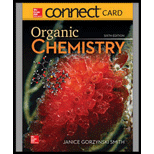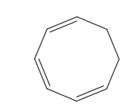
ORGANIC CHEMISTRY-ACCESS
6th Edition
ISBN: 9781260475586
Author: SMITH
Publisher: MCG
expand_more
expand_more
format_list_bulleted
Concept explainers
Textbook Question
Chapter 25.3, Problem 10P
What product would be formed by the disrotatory cyclization of the given triene? Would this reaction occur under photochemical or thermal conditions?

Expert Solution & Answer
Want to see the full answer?
Check out a sample textbook solution
Students have asked these similar questions
PLEASE HELP! URGENT!
"Water gas" is an industrial fuel composed of a mixture of carbon monoxide and hydrogen gases. When this
fuel is burned, carbon dioxide and water result. From the information given below, write a balanced equation
and determine the enthalpy of this reaction:
CO(g) + O2(g) → CO₂(g) + 282.8 kJ
H2(g) + O2(g) → H₂O(g) + 241.8 kJ
MacBook Air
Page of 3
4. Calculate AG for the following reaction at 25°C. Will the reaction occur (be spontaneous)? How do you
know?
NH3(g) + HCl(g) → NH4Cl(s)
AH=-176.0 kJ
AS-284.8 J-K-1
Chapter 25 Solutions
ORGANIC CHEMISTRY-ACCESS
Ch. 25.1 - Prob. 1PCh. 25.2 - Problem 27.2
For each molecular orbital in Figure...Ch. 25.2 - Problem 27.3
(a) Using Figure 27.2 as a guide,...Ch. 25.3 - Prob. 4PCh. 25.3 - Prob. 5PCh. 25.3 - Prob. 6PCh. 25.3 - Prob. 7PCh. 25.3 - Prob. 8PCh. 25.3 - Prob. 9PCh. 25.3 - Problem 27.11
What product would be formed by the...
Ch. 25.4 - Consider cycloheptatrienone and ethylene, and draw...Ch. 25.4 - Problem 27.13
Show that a thermal suprafacial...Ch. 25.4 - Prob. 13PCh. 25.5 - Prob. 17PCh. 25.5 - Prob. 18PCh. 25.5 - Prob. 19PCh. 25.5 - Prob. 20PCh. 25.5 - Prob. 21PCh. 25.5 - Prob. 22PCh. 25.5 - Problem 27.25
(a) What product is formed by the...Ch. 25.6 - Prob. 24PCh. 25 - Prob. 25PCh. 25 - Prob. 26PCh. 25 - Prob. 31PCh. 25 - Prob. 32PCh. 25 - Prob. 33PCh. 25 - Prob. 34PCh. 25 - Prob. 35PCh. 25 - Prob. 36PCh. 25 - Prob. 37PCh. 25 - Prob. 41PCh. 25 - Prob. 42PCh. 25 - Prob. 44PCh. 25 - Prob. 45PCh. 25 - 27.47 What product is formed from the [5,5]...Ch. 25 - 27.52 Draw the products of each reaction.
c....
Knowledge Booster
Learn more about
Need a deep-dive on the concept behind this application? Look no further. Learn more about this topic, chemistry and related others by exploring similar questions and additional content below.Similar questions
- true or false The equilibrium constant for this reaction is 0.20. N2O4(g) ⇔ 2NO2(g) Based on the above, the equilibrium constant for the following reaction is 5. 4NO2(g) ⇔ 2N2O4(g)arrow_forwardtrue or false The equilibrium constant for this reaction is 0.20. N2O4(g) ⇔ 2NO2(g) Based on the above, the equilibrium constant for the following reaction is 0.4. 2N2O4(g) ⇔ 4NO2(g)arrow_forwardtrue or false Using the following equilibrium, if heat is added the equilibrium will shift toward the reactants. N2(g) + 3H2(g) ⇔ 2NH3(g) + heatarrow_forward
- True or False Using the following equilibrium, if heat is added the equilibrium will shift toward the products. N2O4(g) + heat ⇔ 2NO2(g)arrow_forwardtrue or false Using the following equilibrium, if solid carbon is added the equilibrium will shift toward the products. C(s) + CO2(g) ⇔ 2CO(g)arrow_forwardProvide the complete mechanism for the reaction below. You must include appropriate arrows,intermediates, and formal charges. Please also provide a reason to explain why the 1,4-adduct is preferred over the 1,3-adduct.arrow_forward
- Which of the following pairs are resonance structures of one another? I. III. || III IV + II. :0: n P !༠ IV. EN: Narrow_forwardPredict the major organic product(s) and byproducts (either organic or inorganic) for thefollowing reactions.arrow_forwardA 8.25 g sample of aluminum at 55°C released 2500 J of heat. The specific heat of aluminum is 0.900 J/g°C. The density of aluminum is 2.70 g/mL. Calculate the final temperature of the aluminum sample in °C.arrow_forward
arrow_back_ios
SEE MORE QUESTIONS
arrow_forward_ios
Recommended textbooks for you

 Macroscale and Microscale Organic ExperimentsChemistryISBN:9781305577190Author:Kenneth L. Williamson, Katherine M. MastersPublisher:Brooks Cole
Macroscale and Microscale Organic ExperimentsChemistryISBN:9781305577190Author:Kenneth L. Williamson, Katherine M. MastersPublisher:Brooks Cole


Macroscale and Microscale Organic Experiments
Chemistry
ISBN:9781305577190
Author:Kenneth L. Williamson, Katherine M. Masters
Publisher:Brooks Cole
Alcohols, Ethers, and Epoxides: Crash Course Organic Chemistry #24; Author: Crash Course;https://www.youtube.com/watch?v=j04zMFwDeDU;License: Standard YouTube License, CC-BY